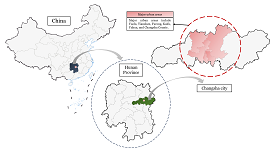
Asia Pacific Academy of Science Pte. Ltd. (APACSCI) specializes in international journal publishing. APACSCI adopts the open access publishing model and provides an important communication bridge for academic groups whose interest fields include engineering, technology, medicine, computer, mathematics, agriculture and forestry, and environment.

As China's pillar industry, the property market has suffered a considerable impact in recent years, with a decline in turnover and many developers at risk of bankruptcy. As one of the most concerned factors for stakeholders, housing prices need to be predicted more objectively and accurately to minimize decision-making errors by developers and consumers. Many prediction models in recent years have been unfriendly to consumers due to technical difficulties, high data demand, and varying factors affecting house prices in different regions. A uniform model across the country cannot capture local differences accurately, so this study compares and analyses the fitting effects of multiple machine learning models using February 2024 new building data in Changsha as an example, aiming to provide consumers with a simple and practical reference for prediction methods. The modeling exploration applies several regression techniques based on machine learning algorithms, such as Stepwise regression, Robust regression, Lasso regression, Ridge regression, Ordinary Least Squares (OLS) regression, Extreme Gradient Boosted regression (XGBoost), and Random Forest (RF) regression. These algorithms are used to construct forecasting models, and the best-performing model is selected by conducting a comparative analysis of the forecasting errors obtained between these models. The research found that machine learning is a practical approach to property price prediction, with least squares regression and Lasso regression providing relatively more convincing results.
OLD city space from the perspective of multi community—Take a floating population community in H city as an example
Vol 1, Issue 1, 2020
Download PDF
Abstract
Taking the specific practice of an old city space as an example, this paper distinguishes the positions and practices of three actors in the space: Urban planners, managers and ordinary citizens hold an extreme modernist position, firmly believing that the old urban space needs to be removed and transformed into a new urban order; Citizens living in the old city space hold a more complex and contradictory position. As the bottom group of the city, they pay attention to the exchange value of community space, but it is difficult to change their living conditions, while maintaining the exclusion of the old city space and the floating population; The floating population builds the old urban space into a space for production and life, making it a "settled community" entering the city. Finally, the diverse position and practice of the old city space show its significance of urbanization and its important role in the construction of urban diversity.
Keywords
References
- Habitat UN. The Challenge of Slums: Global Report on Human Settlements 2003. London: Earthscan; 2003.
- GILBERT A. The Return of the Slum: Does Language Matter? International Journal of Urban and Regional Research. 2007; 31(4): 697-713. doi: 10.1111/j.1468-2427.2007.00754.x
- Gu C, Sheng M. Study on the settlement of graduates from low-income universities in Beijing -- Tangjialing phenomenon and its continuation. Human geography; 2012.
- Wellman B. Studying Personal Community. In: Peter VM &Lin N (editors). Social Structure and Network Analysis. Sage publications; 1982.
- Zheng Z. Individualized society and private community: Criticism based on Chinese community practice, learning and practice. 2012. No. 6.
- Zheng Z, Liang B. Community practice and change from a nonlinear perspective. Social science front; 2016.
- Zhao Y. Right of residence and treatment of citizens: "The Fourth Party group" in urban transformation. Sociological research; 2008.
- Qin A. 2013, From mobile politics to immigration politics -- intergenerational changes of migrant workers' urban integration. Chinese youth research; 2013.
- Fan CC. The Elite, the Natives, and the Outsiders: Migration and Labor Market Segmentation in Urban China. Annals of the Association of American Geographers. 2002; 92(1): 103-124. doi: 10.1111/1467-8306.00282
- Yin H, Gao Y. The paradox of mobility and fixation: The survival dilemma of urban floating population -- Taking the floating population in the prosperous community of H city as an example. Social science front; 2015.
- Scott J. The perspective of the state: What are the failed projects. Beijing Social science literature press; 2004.
- Harvey D. The state of Postmodernism — An inquiry into the origin of cultural change. In: Yan J (editor). Beijing: Commercial Press; 2003.
- Jacobs J. Death and life of American big cities. In: Jin H (editor). Nanjing: Yilin publishing house; 2005.
- Davis, Mike. planet full of slums. In: Pan C (editor). Beijing: Xinxing publishing house; 2009.
- Bauman Z. Legislators and interpreters. In: Hong T (editor). Shanghai People's publishing house; 2000.
- Harvey D. The Right to the City. New Left Review; 2008.
- Sanders D. 2012, Settled City -- the last human migration and our future. In: Chen X (editor). Shanghai Translation Publishing Hous; 2012.
- Schutz A. Real social problems. In: Huo G and Suo X (editors). Huaxia publishing house; 2001.
- Zhou M. Chinatown: "Chinese communities with deep socio-economic potential". In: Bao A (editor). Beijing: Commercial Press; 1995.
- Yin H, Gao Y. Immigrant settlements as the third space of the city -- Enlightenment from settled city. Theory monthly; 2015.
- Wan X, Wang Y, Gao X. From "settled city" to "settled community" -- Enlightenment from the study of immigrants and villages in cities and basic strategies for urban integration services of migrant population. Social work and management; 2016.
- Townsend P. The meaning of poverty. The British Journal of Sociology. 2010; 61(s1): 85-102. doi: 10.1111/j.1468-4446.2009.01241.x
Supporting Agencies
Copyright (c) 2020 Yunhong Gao, Haijie Yin

This work is licensed under a Creative Commons Attribution 4.0 International License.

This site is licensed under a Creative Commons Attribution 4.0 International License (CC BY 4.0).

Prof. Mehmet Cetin
Kastamonu University,
Turkey
Polish Scientific Bibliography

